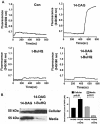14-Deoxyandrographolide desensitizes hepatocytes to tumour necrosis factor-alpha-induced apoptosis through calcium-dependent tumour necrosis factor receptor superfamily member 1A release via the NO/cGMP pathway
- PMID: 20649583
- PMCID: PMC2936852
- DOI: 10.1111/j.1476-5381.2010.00836.x
14-Deoxyandrographolide desensitizes hepatocytes to tumour necrosis factor-alpha-induced apoptosis through calcium-dependent tumour necrosis factor receptor superfamily member 1A release via the NO/cGMP pathway
Abstract
Background and purpose: Andrographis paniculata (AP) has been found to display hepatoprotective effect, although the mechanism of action of the active compounds of AP in this context still remains unclear. Here, we evaluated the hepatoprotective efficacy of 14-deoxyandrographolide (14-DAG), a bioactive compound of AP, particularly its role in desensitization of hepatocytes to tumour necrosis factor-alpha (TNF-alpha)-induced signalling of apoptosis.
Experimental approach: TNF-alpha-mediated ligand receptor interaction in hepatocytes in the presence of 14-DAG was studied in vitro in primary hepatocyte cultures, with the help of co-immunoprecipitation, confocal microscopy and FACS analysis. Events associated with 14-DAG-induced TNFRSF1A release from hepatocytes were determined using immunoblotting, biochemical assay and fluorimetric studies. Pulse-chase experiments with radiolabelled TNF-alpha and detection of apoptotic nuclei by terminal transferase-mediated dUTP nick-end labelling were performed under in vivo conditions.
Key results: 14-DAG down-regulated the formation of death-inducing signalling complex, resulting in desensitization of hepatocytes to TNF-alpha-induced apoptosis. Pretreatment of hepatocytes with 14-DAG accentuated microsomal Ca-ATPase activity through induction of NO/cGMP pathway. This resulted in enhanced calcium influx into microsomal lumen with the formation of TNFRSF1A-ARTS-1-NUCB2 complex in cellular vesicles. It was followed by the release of full-length 55 kDa TNFRSF1A and a reduction in the number of cell surface TNFRSF1A, which eventually caused diminution of TNF-alpha signal in hepatocytes.
Conclusion and implication: Taken together, the results demonstrate for the first time that 14-DAG desensitizes hepatocytes to TNF-alpha-mediated apoptosis through the release of TNFRSF1A. This can be used as a strategy against cytokine-mediated hepatocyte apoptosis in liver dysfunctions.
Figures









Similar articles
-
A role for cGMP in inducible nitric-oxide synthase (iNOS)-induced tumor necrosis factor (TNF) α-converting enzyme (TACE/ADAM17) activation, translocation, and TNF receptor 1 (TNFR1) shedding in hepatocytes.J Biol Chem. 2012 Oct 19;287(43):35887-98. doi: 10.1074/jbc.M112.365171. Epub 2012 Aug 16. J Biol Chem. 2012. PMID: 22898814 Free PMC article.
-
Fructose 1,6-bisphosphate reduced TNF-alpha-induced apoptosis in galactosamine sensitized rat hepatocytes through activation of nitric oxide and cGMP production.Eur J Pharmacol. 2009 May 21;610(1-3):128-33. doi: 10.1016/j.ejphar.2009.03.044. Epub 2009 Mar 24. Eur J Pharmacol. 2009. PMID: 19324037
-
14-Deoxyandrographolide targets adenylate cyclase and prevents ethanol-induced liver injury through constitutive NOS dependent reduced redox signaling in rats.Food Chem Toxicol. 2013 Sep;59:236-48. doi: 10.1016/j.fct.2013.05.056. Epub 2013 Jun 10. Food Chem Toxicol. 2013. PMID: 23764359
-
Naofen promotes TNF-α-mediated apoptosis of hepatocytes by activating caspase-3 in lipopolysaccharide-treated rats.World J Gastroenterol. 2014 May 7;20(17):4963-71. doi: 10.3748/wjg.v20.i17.4963. World J Gastroenterol. 2014. PMID: 24803807 Free PMC article.
-
Decoding cell death signals in liver inflammation.J Hepatol. 2013 Sep;59(3):583-94. doi: 10.1016/j.jhep.2013.03.033. Epub 2013 Apr 6. J Hepatol. 2013. PMID: 23567086 Review.
Cited by
-
Andrographis paniculata (Burm. f.) Wall. ex Nees: a review of ethnobotany, phytochemistry, and pharmacology.ScientificWorldJournal. 2014;2014:274905. doi: 10.1155/2014/274905. Epub 2014 Dec 24. ScientificWorldJournal. 2014. PMID: 25950015 Free PMC article. Review.
-
Marine-Derived Cytosine Arabinoside (Ara-C) Inhibits Biofilm Formation by Inhibiting PEL Operon Proteins (Pel A and Pel B) of Pseudomonas aeruginosa: An In Silico Approach.Mol Biotechnol. 2025 May;67(5):1924-1938. doi: 10.1007/s12033-024-01169-8. Epub 2024 May 13. Mol Biotechnol. 2025. PMID: 38739212
-
In vitro anti-biofilm activity of 14-deoxy-11,12-didehydroandrographolide from Andrographis paniculata against Pseudomonas aeruginosa.Braz J Microbiol. 2020 Mar;51(1):15-27. doi: 10.1007/s42770-019-00169-0. Epub 2019 Nov 6. Braz J Microbiol. 2020. PMID: 31691922 Free PMC article.
-
In silico studies on structural inhibition of SARS-CoV-2 main protease Mpro by major secondary metabolites of Andrographis paniculata and Cinchona officinalis.Biologia (Bratisl). 2022;77(5):1373-1389. doi: 10.1007/s11756-022-01012-y. Epub 2022 Feb 28. Biologia (Bratisl). 2022. PMID: 35250036 Free PMC article.
References
-
- Bhattacharyya K, Kar T, Bocelli G, Cantoni A, Pramanick S, Banerjee S, et al. Reduction of 14-deoxyandrographolide. Acta Cryst. 2005;E61:o2743–o2745.
-
- Brakebusch C, Varfomeev EE, Batkin M, Wallach D. Structural requirements for inducible shedding of the p55 tumor necrosis factor receptor. J Biol Chem. 1994;269:32488–32496. - PubMed
-
- Burgos AF, Loyola M, Hidalgo MA, Labranche TP, Hancke JL. Effect of 14-deoxyandrographolide on calcium-mediated rat uterine smooth muscle contractility. Phytother Res. 2003;17:1011–1015. - PubMed
-
- Burgos RA, Hidalgo MA, Monsalve J, LaBranche TP, Eyre P, Hancke JL. 14-Deoxyandrographolide as a platelet activating factor antagonist in bovine neutrophils. Planta Med. 2005;71:604–608. - PubMed
Publication types
MeSH terms
Substances
LinkOut - more resources
Full Text Sources
Molecular Biology Databases

